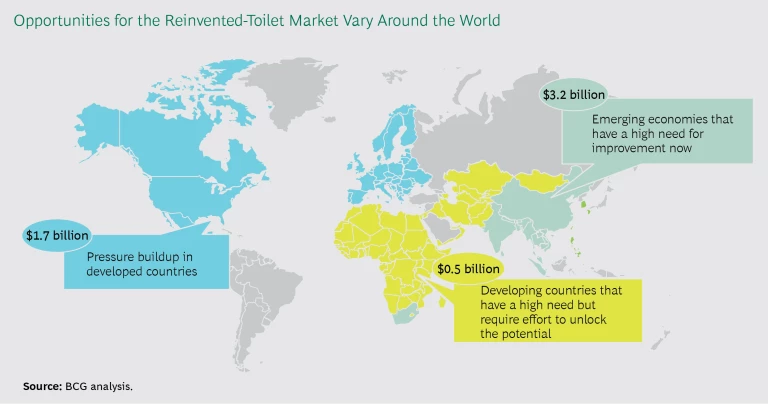To help save millions of people from early death and disease, forward-thinking companies could soon be turning a low-tech problem into the next tech-powered disruption—an approach that makes it possible for businesses to do well while doing good. This potential double win exists thanks to a piece of technology that rarely comes to mind when thinking of new business opportunities and global markets: the humble toilet.
While the toilet has been around for centuries in one form or another, people in many parts of the world still live without this basic technology, using poorly constructed latrines, buckets, or nothing at all, defecating and urinating out in the open. Some 61% of the world’s citizens—4.5 billion people—lack safely managed sanitation, and of these, 2.3 billion still do not have basic services, according to UNICEF . Inadequate sanitation spreads illness, increases risk of diarrheal disease, and kills more children than measles, malaria, HIV, and AIDS combined. What’s more, developing countries aren’t the only ones in need. Aging water and sanitation infrastructure and budget constraints in developed countries are increasing pressure on governments to find new solutions. Making matters worse, supplies of clean water are becoming scarcer around the world, and new water and sanitation infrastructure construction cannot keep pace with population growth, particularly in developing countries.
The good news is that a new suite of technologies could improve sanitation and provide viable alternatives to traditional toilets, septic tanks, and sewerage systems. New ways to remove pathogens from human waste—including wet oxidation, dry combustion, and electrochemical processing—are being developed, making sanitation sustainable, safe, accessible, and affordable. The effort to unlock the potential of these solutions is in its earliest stages, and many technologies are still under development. But combined with a wave of policy priorities, significant potential revenue streams exist for companies—from global multinationals to local sanitation firms—in a market estimated to be worth around $6 billion annually by 2030. Those that use their existing businesses to address this market will help improve human health and save lives, thus creating a total societal impact that greatly enhances their long-term financial performance.
Significant potential revenue streams exist for companies in a market estimated to be worth around $6 billion annually by 2030.
Tech Disruption Comes to Sanitation
Many of the new sanitation technologies have emerged from the Reinvent the Toilet Challenge, an initiative launched in 2011 by the Bill & Melinda Gates Foundation, which funded innovators developing alternative sanitation technologies. Technologies under development for the reinvented toilet include dry combustion (which converts human waste to a charcoal briquette type of fuel instead of flushing it away with water), wet oxidation (in which materials suspended in water are broken down using oxygen), and electrochemical processing (which uses metal oxides).
These emerging technologies remove the pathogens that can cause disease from human waste, eliminate safety concerns for service providers handling the waste processing, and promote environmental sustainability. The absence of fecal sludge transportation also reduces the risk of pollution and disease.
Many of the systems are being designed to operate off the grid, without connections to water and sewer systems or electrical lines. This means that sanitation solutions could be installed in parts of the world lacking access to power supplies and other infrastructure. With modular, portable, easy-to-install formats, they could allow for increases in use as populations expand and make it possible to extend safe sanitation to remote locations where sewage systems or septic tanks might not be feasible.
The technologies under development could also help conserve valuable resources. They have low electricity and water requirements, minimizing their environmental footprint through reduced energy and water use. They also offer the possibility of recovering valuable energy, clean water, and nutrients from waste processing.
The new technologies could cost less to construct, install, and maintain than septic tanks and sewage systems. Reduced pit emptying and the absence of piped collection and fecal sludge transportation would make maintenance and operation cheaper. And with the potential for local companies to provide postinstallation and maintenance services, these solutions could offer both low life cycle costs and sustainable business models.
The combination of low cost, high safety levels, flexibility, and low environmental risk means that reinvented-toilet technologies could play a critical role in accelerating progress toward meeting the UN Sustainable Development Goals (SDGs): Goal 6 aims to make sustainable management of water and sanitation available to all, and to end open defecation, by 2030.
What’s more, by providing privacy, accessibility, and a clean, safe product that eliminates odors and waste, reinvented-toilet technologies could enhance human dignity in communities around the world.
Reinvented-toilet technologies could enhance human dignity in communities around the world.
The Size of the Prize
The new sanitation technologies can be deployed in both developing and developed countries, and the size of the opportunity varies depending on the setting. In developed countries that are building on current sanitation infrastructure, a potential market exists of about $1.7 billion annually. Meanwhile, emerging economies with high needs, market readiness, and national policies prioritizing improvements in sanitation offer a $3.2 billion opportunity, even taking into account lower price points. (See the exhibit.)
Markets also vary in terms of the relative ease of entry and the pace at which governments are implementing improvements and looking for solutions providers to step in.
In many developing countries, lack of access to sewerage is likely to persist through 2030, prompting demand for sanitation solutions. In some nations—such as countries in Africa—the high demand and potential development impact of new sanitation technologies correlate with greater time and effort needed to unlock their markets. This underlines the urgency of finding ways to accelerate entry into these markets.
While demand is significant in developing countries, opportunities are opening up even in developed countries, given that existing sewer systems are often more than a century old. In the US, the cost of meeting current and future demand for wastewater treatment plants is estimated to be at least $271 billion, according to the American Society of Civil Engineers. When deployed at scale, standalone, closed-loop reinvented toilets could help reduce wastewater treatment infrastructure costs.
In Europe, large swaths of the population are underserved by sanitation systems. In Poland, for example, an estimated 3.2 million households in poor, rural areas lack sewers. Of these, about 2.8 million are in small villages whose municipalities are not required to provide sewerage, leaving households to rely on septic tanks—which pose the risk of degradation and soil and groundwater pollution. Another 400,000 are in midsize towns whose municipalities are exempt from having to provide sewerage.
Demand Meets a Favorable Policy Environment
Across the world, recognition of the need to address the sanitation challenge is rising. In the process, favorable policies are emerging. The SDGs provide an overarching global agenda. Meanwhile, countries are individually setting policy priorities and making significant investment decisions. Three key markets—China, India, and the US—illustrate the potential opportunity. And while the challenges they face vary, all three are prioritizing both high-visibility sites and areas of high need:
- China. With a vast population, China represents a large portion of the market prize. For the government, high-visibility sites include toilets at tourist attractions. Rural communities, meanwhile, constitute the area of highest need, since many have no piped access. Ambitious sanitation goals include universal sewage coverage. However, obstacles such as challenging land access, geological conditions, and the need to protect natural resources mean that, in many places, piped sewage treatment facilities would be inappropriate or unfeasible. Reinvented-toilet technologies could fill the gaps, particularly as China is seeking commercial builders that meet environmental sustainability standards and certifications.
- India. The ambitious Swachh Bharat (Clean India) campaign has exceeded its goal of installing 75 million toilets by 2019. The government reports that India has now built 87.2 million toilets. In 2015, the World Bank approved a $1.5 billion loan to support the rural component of the Swachh Bharat mission. India is prioritizing high-visibility sites (public and community toilets) and high-need areas (slum redevelopments and affordable housing) and is seeking premium or midsegment apartment developers as suppliers. While traditional sanitation infrastructure will be used to help meet the country’s sanitation goals, the low-cost, modular formats, and the potential for installation in off-grid and rural areas, make reinvented-toilet technologies particularly compelling in India.
- The US. Here, the challenge is to upgrade deteriorating infrastructure and overburdened systems. In Pittsburgh, for example, leaking pipes and breaches of environmental standards are creating an urgent need to invest in water and sanitation infrastructure. But with the outlay for repair estimated at more than $2.5 billion, reinvented-toilet solutions are becoming an attractive alternative. The environmental agenda is also driving demand. In San Francisco, for example, state and local policies encourage green practices that promote water conservation. For instance, one new ordinance, prompted by the 2016 drought, requires provision of onsite nonpotable-water reuse systems for new buildings with more than 250,000 square feet in gross floor area, paving the way for technologies that provide alternatives to water-flush toilets.
For China, India, and the US, the principal push is to construct or upgrade sewerage infrastructure. However, given the scale of demand and the challenges of installing traditional sanitation services in many places, technologies with modular, low-cost, low-energy formats and low water use will be an important part of the toolkit.
Cultivating Early Adopters
For companies wanting to seize this new opportunity, the challenge will be to find the most effective means of entering the market. And as with any new product or service, early adopters can be critical. Early adopters build momentum for demand by acting as champions, trendsetters, and opinion leaders. They can demonstrate proof of concept and provide feedback on early models or pilots that inform the design of products and services.
- Companies can roll out new sanitation technologies to meet increased demand created by conflict, health crises, or natural disasters, such as the rapid expansion of refugee camps, the Ebola outbreak in West Africa, and the decimation of infrastructure in Puerto Rico in the wake of Hurricane Maria. In these situations, providing education and raising awareness can persuade consumers to switch to new products or services.
- Crossover strategies are another approach. Applications for the military or for remote tourism sites can be developed before being launched for mainstream uses. Few examples have yet to emerge in sanitation, but such strategies have been used to resolve water scarcity issues. In drought-ridden Israel, for instance, the Israeli company Watergen developed technology that produces drinking water from the humid air. The Israeli Defense Forces, which wanted to reduce the need to carry water in the field, was the company’s first target customer. Since then, the company has expanded into smaller-scale civilian products. Its markets include Hyderabad, India, where Watergen is working with Tata Projects to address India’s drinking-water challenge.
- Targeting early adopters means being willing to take on the risk of investing before demand has materialized. But cultural barriers can hamper adoption even when demand is high. For example, in a water-scarce area of Bolivia that lacked sanitation facilities, dry toilets were not installed because communities wanted flush toilets. To mitigate the risks, companies need to build aspirations and promote the benefits of the new technologies through community education. In the early stages, they can also work in several locations to spread investment risk and capture demand at sufficient volume before moving into more mainstream markets.
Tapping into an Established Ecosystem
The reinvented toilet is a new concept, and engaging with local players will not always be easy. This is the case in some African countries, where challenging dynamics make unlocking the revenue potential tougher. In Nigeria, for example, only one-third of the population has access to basic sanitation, and this percentage is shrinking because services cannot keep up with the expanding population. Yet the perceived low quality of local manufacturing, high importing costs, and risks such as corruption create barriers to entry.
However, even in tough markets, the fact that the sanitation sector is well established creates opportunities for partnership with commercial players. And, given that improving sanitation has become a focus for the development community, partnering with local nonprofits and international agencies can build trust among users of the new systems. Companies can follow a number of strategies to ease market entry:
- Providers of reinvented toilets can work across the value chain with toilet and septic tank manufacturers, plumbing suppliers, contractors, and architects. Even rural markets in some countries, such as China, have established distribution and sales channels and after-market support for the sale of white goods and similar products.
- Existing commercial enterprises can become partners with companies rolling out reinvented-toilet solutions. For example, in Kenya, slow government progress on sanitation has encouraged a number of entrepreneurs to address sanitation. Partnering with one of these enterprises offers accelerated market entry.
- To increase adoption, companies can work with communities to help educate local populations about proper sanitary practices. For example, WaterHealth International, a US-based social business that provides safe drinking water to urban and rural areas, implements a comprehensive health and hygiene program to encourage behavioral change. Among other things, the program allows women to view samples of untreated water under a microscope to recognize bacteria and understand how it could harm them and their families.
- International agencies can become champions of, and credible partners for, new sanitation products and services. In the water sector, for example, WaterHealth’s partnership with the US Agency for International Development has helped the company build credibility and recognition for its products and services while substantially expanding access to safe water. And the United Nations High Commissioner for Refugees could use reinvented-toilet technologies to meet sanitation needs and mitigate health risks, such as cholera outbreaks, in its projects supporting Zaatari, an established refugee camp in Jordan, and the Rohingya refugee camp in Bangladesh, which has a population of more than 1 million.
Reaping Social and Financial Returns
Global sanitation illustrates how companies can use their core business activities to create positive social impact. In the case of the reinvented toilet, providing the technologies that improve global health allows companies across the value chain to tap into a valuable revenue stream. BCG research on total societal impact has found that companies taking this approach tend to outperform others in their sector. (See Total Societal Impact: A New Lens for Strategy , BCG report, October 2017.) For example, in the consumer goods sector, BCG found that top performers on key societal-impact topics enjoyed an 11% valuation premium and those focused specifically on conserving water had a 5.5 percentage point gross-margin premium when compared with median performers.
Opportunities in the sanitation sector could be similar. If companies can harness early adopters, tap into established ecosystems, and do so while the policy environment is favorable to large-scale investments, the rewards look extremely attractive. The opportunities may not last forever. The ability to address an urgent human need and create a new revenue stream should provide a compelling argument for any company to develop plans and start putting them into action without delay.











